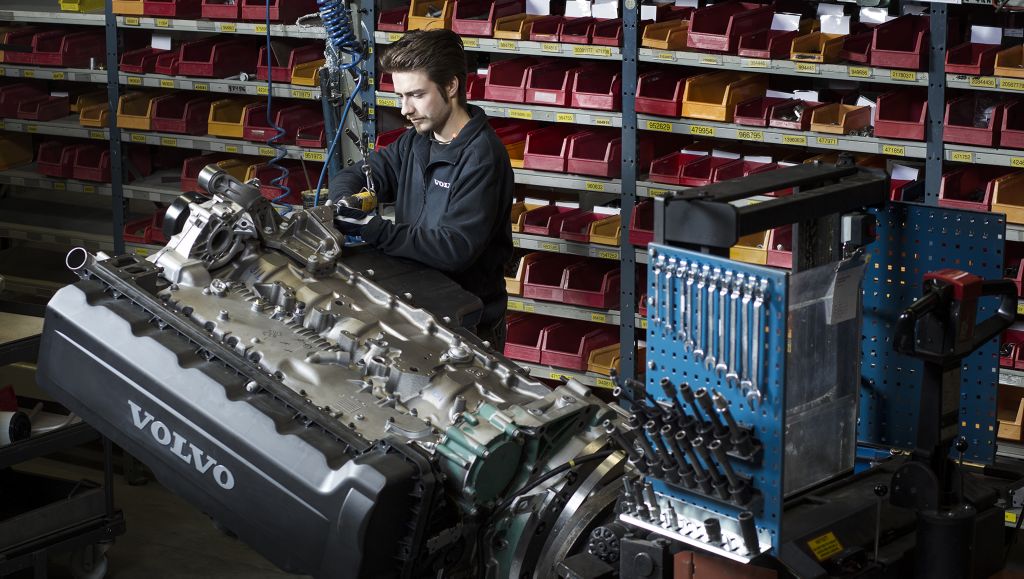Engines revived


Outside the low buildings at the Volvo Parts Plant in Flen, Sweden, rows of engines are waiting under blue plastic sheeting before being allowed to come in to the warmth. All engines that are returned by Volvo Trucks’ dealers in Europe and Asia are sent here. Engines are one of 40 different exchange parts Volvo Trucks offers its customers and take the longest to remanufacture.
“It takes around 57 hours from the moment the engine is brought into the plant until it has been tested and painted,” explains Lars Färnskog, plant manager in Flen.
The remanufacturing process begins with dismantling. The entire engine is taken apart, the parts that cannot be reclaimed are sent for recycling, while the parts that can be remanufactured are sent for cleaning and blasting. Once the moisture, oil residue and paint have disappeared, the parts move on to the machining department.
Here, many surfaces on parts such as the cylinder heads, crankshafts and engine blocks are sanded and milled with great precision and care.
“All the engines come here for a reason. However, as we don’t know how an engine has been used, it’s important to make sure that there are no uneven surfaces,” says Jörgen Karlsson, a cylinder head renovator.
Like many of his colleagues, he knows a huge amount about engines. Remanufacturing requires top-class skills. At the plant in Flen, 150-200 different truck engine variants are remanufactured for Volvo Trucks.
“Most of the engines that arrive here are between eight and nine years old. However, we sometimes receive engines from the 1970s! We make sure that we also take very good care of them,” adds Jörgen Karlsson.
During the journey through the plant, every engine component is inspected in several stages. When the time comes for testing, the engine has to pass the same tests as a newly produced model.
“A reconditioned engine carries the same warranty conditions as Genuine Volvo Parts and has the same quality, durability and performance,” says Lars Färnskog.
In addition to all the parts being remanufactured or replaced with new ones, updates are made in accordance with the latest specifications for each specific model. This means that the engines leaving Flen are as good as new – at the every least.
“We make sure that everything, from fuel access to software, is optimised. The customers who choose to purchase a remanufactured engine get a better product at a much lower price and, at the same time, they make an environmental contribution,” says Lars Färnskog.
Compared with a newly produced truck engine, the energy consumption of a remanufactured engine is 85 per cent lower. The corresponding figure for the consumption of raw material is 80 per cent. Lars Färnskog is convinced that the large-scale environmental benefits are going to increase the demand for exchange parts.
“We know that the world’s natural resources are limited and that the price of raw materials is rising. At the same time, our customers are stepping up their demand for our products to be sustainable and re-usable,” he says.
To enable cores like transmissions and engines to be remanufactured, it is important that they are prepared for this at the design stage. For this reason, the plant in Flen collaborates closely with product development and contributes input to projects at an early stage.
“Preparing products for a second life represents enormous value for the company, our customers and the environment,” says Lars Färnskog.
Preparing products for a second life represents enormous value for the company, our customers and the environment.
40 – The number of Volvo exchange parts Volvo Trucks offers – everything from filters and pumps to transmissions and engines.
85% – The reduction in energy consumption when a truck engine is remanufactured compared with new production.
80% – The reduction in raw material consumption when a truck engine is remanufactured compared with new production.
90% – The level of recycling in an old truck engine.
57 – The average number of hours it takes to remanufacture a truck engine.
150–200 – The number of different Volvo Trucks engine variants that are remanufactured.
210 – The number of employees.
27,000 m2 – The total area of the plant.